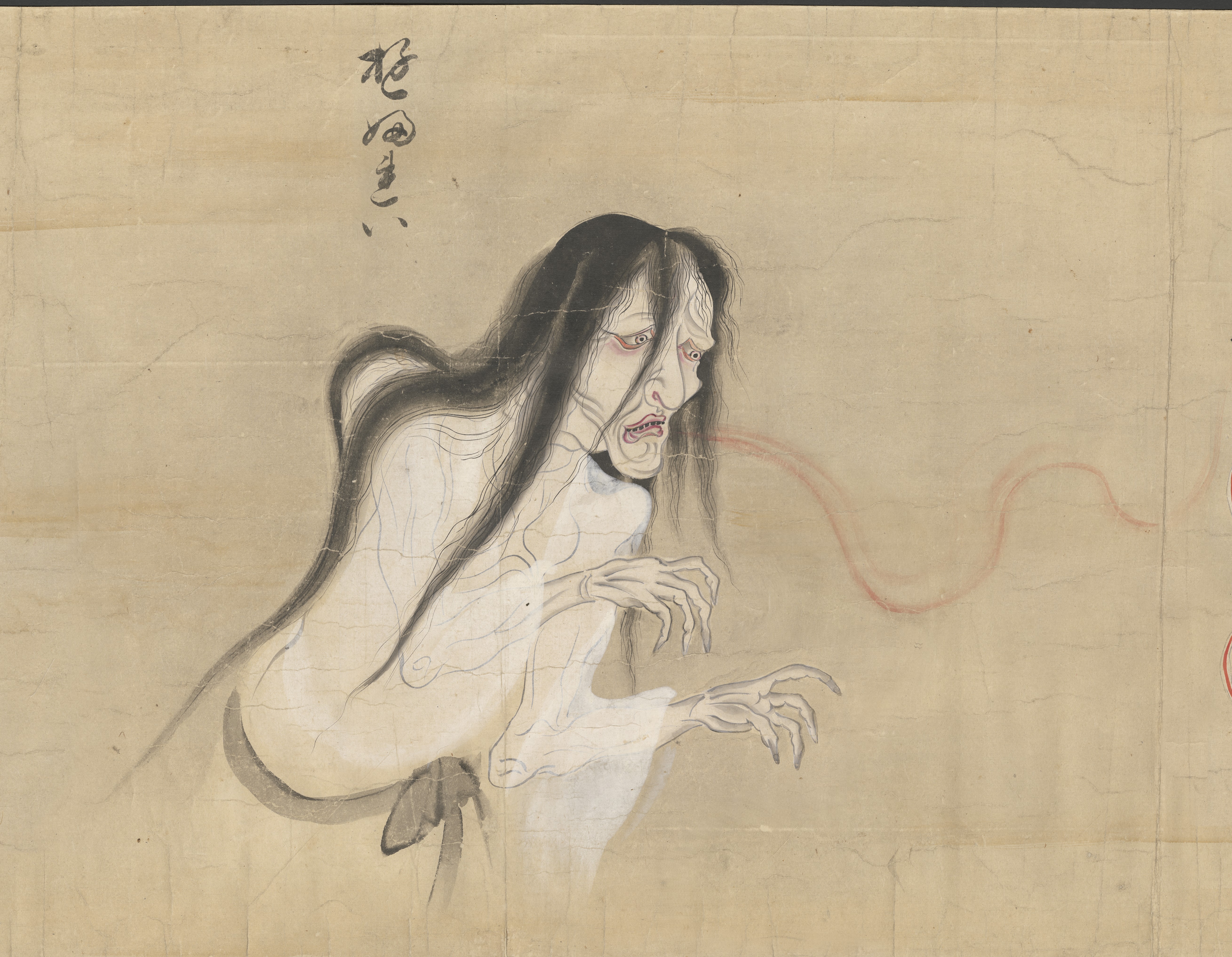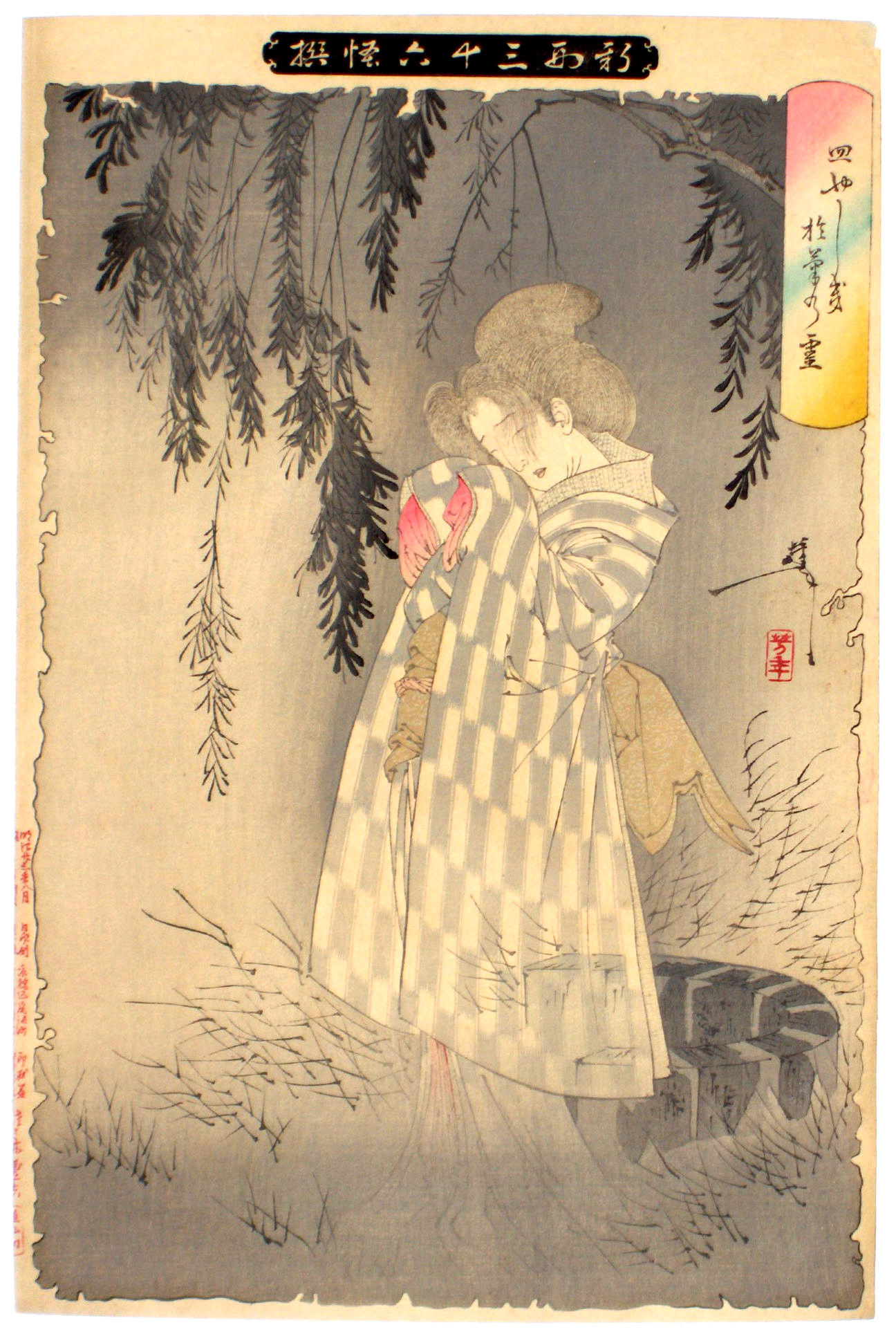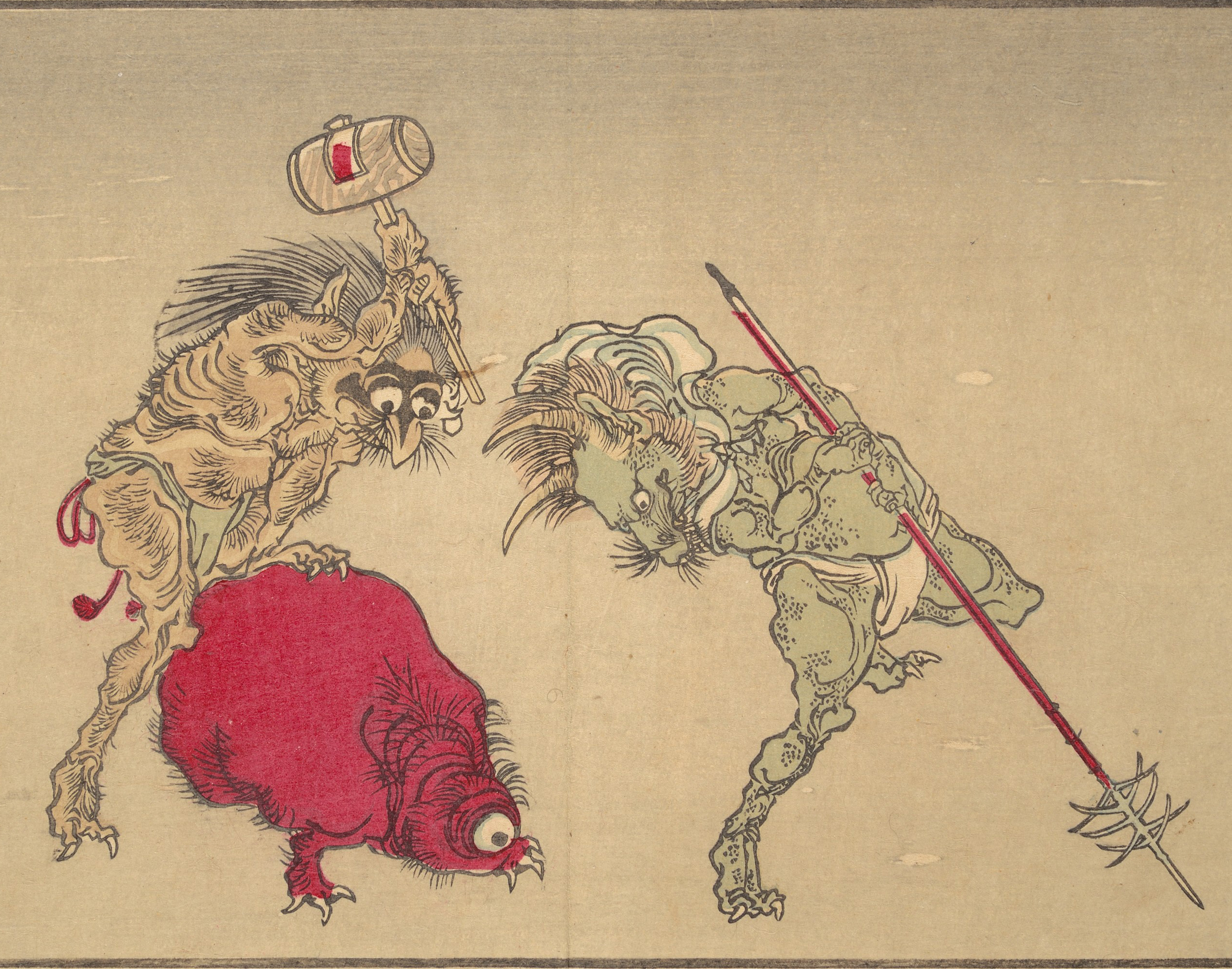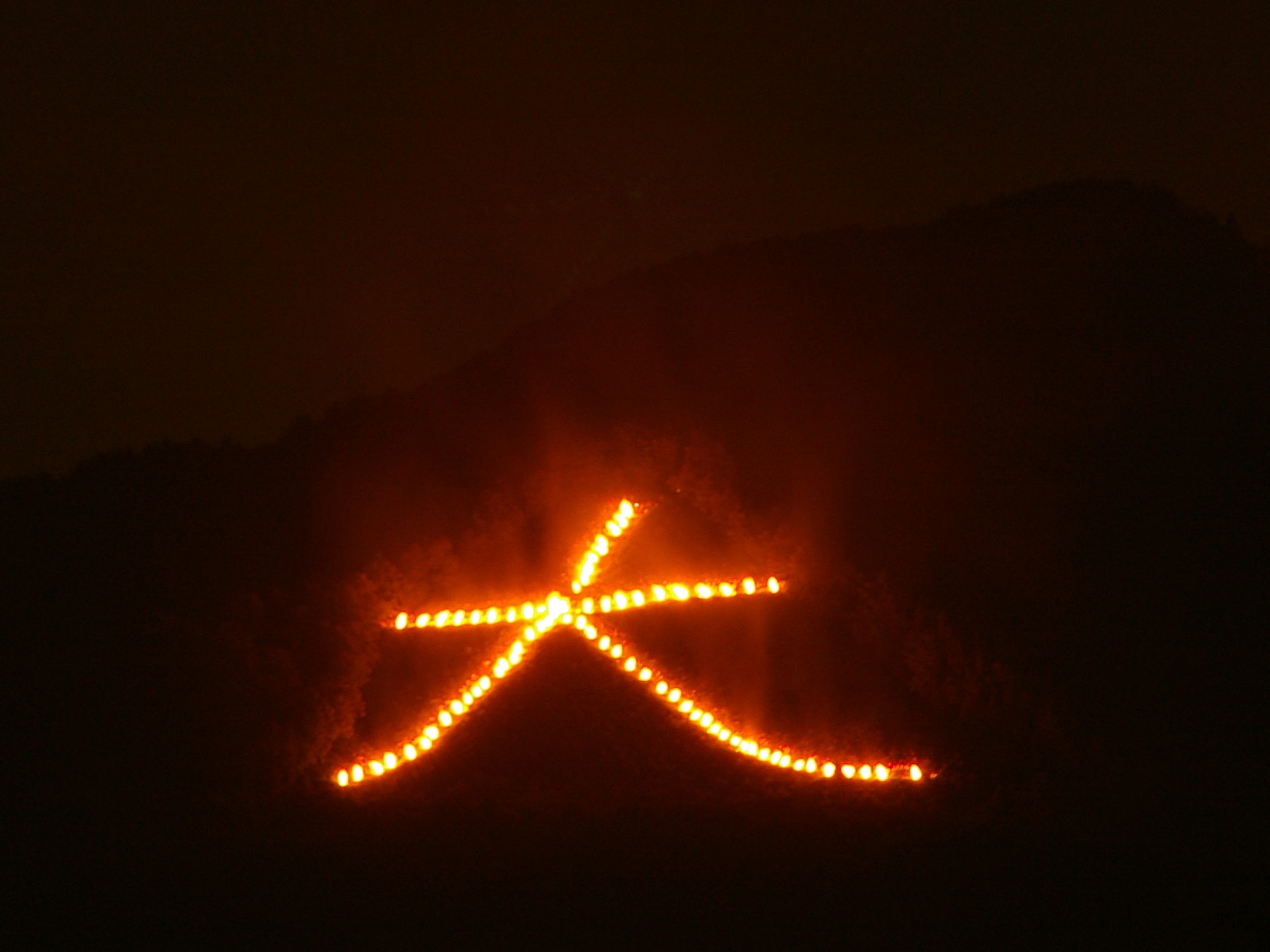|
Yūrei
are figures in Japanese folklore analogous to the Western model of ghosts. The name consists of two kanji, (''yū''), meaning "faint" or "dim" and (''rei''), meaning "soul" or "spirit". Alternative names include , meaning ruined or departed spirit, , meaning dead spirit, or the more encompassing or . Like their Chinese, Korean, and Western counterparts, they are thought to be spirits barred from a peaceful afterlife. Japanese afterlife According to traditional Japanese beliefs, all humans have a spirit or soul called a . When a person dies, the ''reikon'' leaves the body and enters a form of purgatory, where it waits for the proper funeral and post-funeral rites to be performed so that it may join its ancestors. If this is done correctly, the ''reikon'' is believed to be a protector of the living family and to return yearly in August during the Obon Festival to receive thanks. If the person dies, however, in a sudden or violent manner such as murder or suicide, if the pr ... [...More Info...] [...Related Items...] OR: [Wikipedia] [Google] [Baidu] |
Ghost
A ghost is the soul or spirit of a dead person or animal that is believed to be able to appear to the living. In ghostlore, descriptions of ghosts vary widely from an invisible presence to translucent or barely visible wispy shapes, to realistic, lifelike forms. The deliberate attempt to contact the spirit of a deceased person is known as necromancy, or in spiritism as a ''séance''. Other terms associated with it are apparition, haunt, phantom, poltergeist, shade, specter or spectre, spirit, spook, wraith, demon, and ghoul. The belief in the existence of an afterlife, as well as manifestations of the spirits of the dead, is widespread, dating back to animism or ancestor worship in pre-literate cultures. Certain religious practices—funeral rites, exorcisms, and some practices of spiritualism and ritual magic—are specifically designed to rest the spirits of the dead. Ghosts are generally described as solitary, human-like essences, though stories of ghostly armies and th ... [...More Info...] [...Related Items...] OR: [Wikipedia] [Google] [Baidu] |
Kaidan (parapsychology)
is a Japanese word consisting of two kanji: 怪 (''kai'') meaning "strange, mysterious, rare, or bewitching apparition" and 談 (''dan'') meaning "talk" or "recited narrative". Overall meaning and usage In its broadest sense, ''kaidan'' refers to any ghost story or horror story, but it has an old-fashioned ring to it that carries the connotation of Edo period Japanese folktales. The term is no longer as widely used in Japanese as it once was: Japanese horror books and films such as '' Ju-on'' and ''Ring'' would more likely be labeled by the ''katakana'' . ''Kaidan'' is only used if the author/director wishes to specifically bring an old-fashioned air into the story. Examples of ''kaidan'' *''Banchō Sarayashiki'' (''The Story of Okiku'') by Okamoto Kido *''Yotsuya Kaidan'' (''Ghost Story of Tōkaidō Yotsuya'') by Tsuruya Nanboku IV (1755–1829) *'' Botan Dōrō'' (''The Peony Lantern'') by Asai Ryoi *'' Mimi-nashi Hōichi'' (''Hōichi the Earless'') ''Hyakumonogatari Kai ... [...More Info...] [...Related Items...] OR: [Wikipedia] [Google] [Baidu] |
Banchō Sarayashiki
is a Japanese ghost story (kaidan) of broken trust and broken promises, leading to a dismal fate. Alternatively referred to as the tradition, all versions of the tale revolve around a servant, who dies unjustly and returns to haunt the living. Some versions take place in or , others in the area in Edo. History The story of the death of Okiku () first appeared as a bunraku play called ''Banchō Sarayashiki'' in July 1741 at the Toyotakeza theater. The familiar ghost legend had been adapted into a ''ningyō jōruri'' production by Asada Iccho and Tamenaga Tarobei I. Like many successful bunraku shows, a kabuki version followed and in September 1824, ''Banchō Sarayashiki'' was staged at the Naka no Shibai theater starring Otani Tomoemon II and Arashi Koroku IV in the roles of Aoyama Daihachi and Okiku. A one-act kabuki version was created in 1850 by Segawa Joko III, under the title ''Minoriyoshi Kogane no Kikuzuki,'' which debuted at the Nakamura-za theater and starred Ich ... [...More Info...] [...Related Items...] OR: [Wikipedia] [Google] [Baidu] |
Yotsuya Kaidan
, the story of Oiwa and Tamiya Iemon, is a tale of betrayal, murder and ghostly revenge. Arguably the most famous Japanese ghost story of all time, it has been adapted for film over 30 times and continues to be an influence on Japanese horror today. Written in 1825 by Tsuruya Nanboku IV as a kabuki play, the original title was . It is now generally shortened, and loosely translates as ''Ghost Story of Yotsuya.'' History First staged in July 1825, ''Yotsuya Kaidan'' appeared at the Nakamuraza Theater in Edo (the former name of present-day Tokyo) as a double-feature with the immensely popular '' Kanadehon Chushingura.'' Normally, with a Kabuki double-feature, the first play is staged in its entirety, followed by the second play. However, in the case of ''Yotsuya Kaidan'' it was decided to interweave the two dramas, with a full staging on two days: the first day started with ''Kanadehon Chushingura'' from Act I to Act VI, followed by ''Tōkaidō Yotsuya Kaidan'' from Act I to ... [...More Info...] [...Related Items...] OR: [Wikipedia] [Google] [Baidu] |
Yōkai
are a class of supernatural entities and spirits in Japanese folklore. The word is composed of the kanji for "attractive; calamity" and "apparition; mystery; suspicious." are also referred to as , or . Despite often being translated as such, are not literally demons in the Western sense of the word, but are instead spirits and entities. Their behavior can range from malevolent or mischievous to benevolent to humans. often have animal features (such as the , depicted as appearing similar to a turtle, and the , commonly depicted with wings), but may also appear humanoid in appearance, such as the . Some resemble inanimate objects (such as the ), while others have no discernible shape. are typically described as having spiritual or supernatural abilities, with shapeshifting being the most common trait associated with them. that shapeshift are known as or . Japanese folklorists and historians explain as personifications of "supernatural or unaccountable phenomena to th ... [...More Info...] [...Related Items...] OR: [Wikipedia] [Google] [Baidu] |
Reikon
, in Shinto and Japanese Buddhism, is the equivalent to the soul or spirit in western culture. Japanese tradition When a person dies, it is believed that their ''reikon'' will remain in a type of purgatory until they are given proper funeral rites. After which, the ''reikon'' will join their ancestors in the afterlife and only returning to the living world every August for the Obon Festival. ''Yūrei'' When a person dies in an unexpected, violent or traumatic way, the ''reikon'' remains amongst the living as a ''yūrei'', or ghost, who must complete an unfinished duty amongst the living or be given a proper ritual to ease its passing into the next world. A ''yūrei'' is thought to be produced by violent means such as murder or suicide. These tend to take on a fixed desire emotion such as revenge, love, jealousy, hatred, or sorrow while carrying out their hauntings. See also * ''Mitama The Japanese word refers to the spirit of a ''kami'' or the soul of a dead person. It is com ... [...More Info...] [...Related Items...] OR: [Wikipedia] [Google] [Baidu] |
Oyuki
The ''Urusei Yatsura'' manga series features a large ensemble cast of characters created by Rumiko Takahashi. It tells the story of Japanese teenager Ataru Moroboshi, and the alien Lum, who believes she is Ataru's wife after he accidentally proposes to her. The series contains many other characters, whose unusual characteristics and eccentric personalities drive most of the stories. In addition to extraterrestrials, it includes many appearances from figures in Japanese mythology and history. Main characters Ataru Moroboshi is the main protagonist of the series. A 17-year-old lazy student at Tomobiki High School, Class 2-4, Ataru suffers from an incredible amount of bad luck, having been born on Friday the 13th, during a major earthquake, and '' Butsumetsu'', the unluckiest day of the Buddhist calendar. Thanks to this lack of good fortune, his triumph in the game of tag that saves Earth from an Oni invasion turns into a defeat for him. His victory statement, intended to confi ... [...More Info...] [...Related Items...] OR: [Wikipedia] [Google] [Baidu] |
Suicide
Suicide is the act of intentionally causing one's own death. Mental disorders (including depression, bipolar disorder, schizophrenia, personality disorders, anxiety disorders), physical disorders (such as chronic fatigue syndrome), and substance abuse (including alcoholism and the use of and withdrawal from benzodiazepines) are risk factors. Some suicides are impulsive acts due to stress (such as from financial or academic difficulties), relationship problems (such as breakups or divorces), or harassment and bullying. Those who have previously attempted suicide are at a higher risk for future attempts. Effective suicide prevention efforts include limiting access to methods of suicide such as firearms, drugs, and poisons; treating mental disorders and substance abuse; careful media reporting about suicide; and improving economic conditions. Although crisis hotlines are common resources, their effectiveness has not been well studied. The most commonly adopted metho ... [...More Info...] [...Related Items...] OR: [Wikipedia] [Google] [Baidu] |
Obon
or just is fusion of the ancient Japanese belief in ancestral spirits and a Japanese Buddhist custom to honor the spirits of one's ancestors. This Buddhist–Confucian custom has evolved into a family reunion holiday during which people return to ancestral family places and visit and clean their ancestors' graves when the spirits of ancestors are supposed to revisit the household altars. It has been celebrated in Japan for more than 500 years and traditionally includes a dance, known as . The festival of Obon lasts for three days; however, its starting date varies within different regions of Japan. When the lunar calendar was changed to the Gregorian calendar at the beginning of the Meiji era, the localities in Japan responded differently, which resulted in three different times of Obon. (Bon in July) is based on the solar calendar and is celebrated around the 15th of July in eastern Japan ( Kantō region such as Tokyo, Yokohama and the Tōhoku region), coinciding with . ... [...More Info...] [...Related Items...] OR: [Wikipedia] [Google] [Baidu] |
Murder
Murder is the unlawful killing of another human without justification (jurisprudence), justification or valid excuse (legal), excuse, especially the unlawful killing of another human with malice aforethought. ("The killing of another person without justification or excuse, especially the crime of killing a person with malice aforethought or with recklessness manifesting extreme indifference to the value of human life.") This state of mind may, depending upon the jurisdiction (area), jurisdiction, distinguish murder from other forms of unlawful homicide, such as manslaughter. Manslaughter is killing committed in the absence of Malice (law), ''malice'',This is "malice" in a technical legal sense, not the more usual English sense denoting an emotional state. See malice (law). brought about by reasonable Provocation (legal), provocation, or diminished capacity. Involuntary manslaughter, ''Involuntary'' manslaughter, where it is recognized, is a killing that lacks all but the most a ... [...More Info...] [...Related Items...] OR: [Wikipedia] [Google] [Baidu] |
Haunting
The list of reportedly haunted locations throughout the world, that are locations said to be haunted by ghosts or other supernatural beings, including demons. Reports of haunted locations are part of ghostlore, which is a form of folklore. Argentina * Cinco Saltos in Río Negro (Argentina), Río Negro has been reported to have a number of ghosts, most of them reportedly the result of witchcraft. In 2009, an intact corpse of an 8- to 12-year-old girl who had died in the 1930s was found in a cemetery ossuary. Australia * Aradale Mental Hospital, Ararat Lunatic Asylum, or Aradale, is the largest abandoned History of psychiatric institutions, lunatic asylum in Ararat, Victoria, Ararat. Opened in 1867, Aradale was reserved for many of the incurable mental patients in Victoria during the 1800s. An estimated 13,000 people died here during 140 years of operation. * Beechworth Asylum, Beechworth Lunatic Asylum in Beechworth, Victoria is reportedly haunted by several ghosts of depart ... [...More Info...] [...Related Items...] OR: [Wikipedia] [Google] [Baidu] |
Earth
Earth is the third planet from the Sun and the only astronomical object known to harbor life. While large volumes of water can be found throughout the Solar System, only Earth sustains liquid surface water. About 71% of Earth's surface is made up of the ocean, dwarfing Earth's polar ice, lakes, and rivers. The remaining 29% of Earth's surface is land, consisting of continents and islands. Earth's surface layer is formed of several slowly moving tectonic plates, which interact to produce mountain ranges, volcanoes, and earthquakes. Earth's liquid outer core generates the magnetic field that shapes the magnetosphere of the Earth, deflecting destructive solar winds. The atmosphere of the Earth consists mostly of nitrogen and oxygen. Greenhouse gases in the atmosphere like carbon dioxide (CO2) trap a part of the energy from the Sun close to the surface. Water vapor is widely present in the atmosphere and forms clouds that cover most of the planet. More solar e ... [...More Info...] [...Related Items...] OR: [Wikipedia] [Google] [Baidu] |




.jpg)

